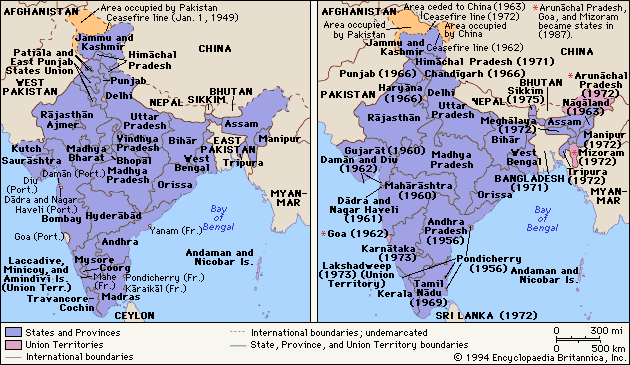Continued from here
With similar culture and past India has developed a vibrant democracy which functions without conflict (bombings in Syria, Iraq, Egypt or Lebanon are no comparison to the problems of Naxalism or Communal tensions we see in India), with a unfettered record of elections and democratically elected governments, and with an unprecedented record of development.
So, what makes India tick which most other Eastern nations experimenting with democracy lack? The answer may lie in this column by Sidin Vadukut which explains how the Indian delegation to help resolve the Israel-Palestine conflict in 1947 proposed setting up of a federal republic instead of the two-nation Israel-Gaza-West Bank state that struggles in conflict today. I quote:
Unlike the popular perception in the West – the term India or Indians do not refer to one single group of people’s like the English or French. The term Indian is as broad as the term ‘European’ representing an ethnic class composed of several sub communities. In fact, the term ethnic class is also incorrect because over 500 years of immigration and invasions have resulted in India being home to several ethnic groups.
More interestingly the Indian ethnic tribe is divided into several overlapping sections like nationality, religion, linguistic community, regional communities, and caste/sub-castes. Unlike Europe where nationality, linguistic identity and community overlap almost exactly, among Indians they do not.
In fact the most evident distinction, nationality, transcends over linguistic and communal identities. Sri Lankans can be Tamil, so can be Indian nationals, Pakistanis can be Punjabi, Sindhi, etc, so would be Indian nationals. Bangladeshis are Bengalis, so are many Indian nationals!
Even within the Indian nationality people can be classified into religious and sectarian sections like Hindus, Muslims, Christians, Sikhs, Buddhists, Jains, and several small tribal sects. Then come linguistic distinctions – Hindi, Marathi, Bengali, Punjabi, Oriya, Assamese, Kannads, Malayali, Telugu, Kashmiris, Dogris and so on. And finally each of these is also marred by the age-old caste distinctions and economic classification. All these sections co-exist creating a complex mesh of sensitivities, variety, cultural orientations and beliefs.
The biggest achievement of the Indian constitution has been its use of Federal government structure to resolve 'ethnic' differences. While the US may claim to be the first to have used the federal structure, the makers of the Indian constitution used it most effectively to combine a divided people into one nation.
How did the Indian constitution's use the Federal government model to melt divided identities into a united nationality?
Read on for more
This post is a part of the series Problems of Middle East and the Indian model as a solution
With similar culture and past India has developed a vibrant democracy which functions without conflict (bombings in Syria, Iraq, Egypt or Lebanon are no comparison to the problems of Naxalism or Communal tensions we see in India), with a unfettered record of elections and democratically elected governments, and with an unprecedented record of development.
So, what makes India tick which most other Eastern nations experimenting with democracy lack? The answer may lie in this column by Sidin Vadukut which explains how the Indian delegation to help resolve the Israel-Palestine conflict in 1947 proposed setting up of a federal republic instead of the two-nation Israel-Gaza-West Bank state that struggles in conflict today. I quote:
India, Iran and Yugoslavia, instead, proposed a minority plan that would avoid partition: “An independent federal State of Palestine shall be created following a transitional period not exceeding three years. The independent Federal State of Palestine shall comprise an Arab state and a Jewish state.” The proposal goes on to describe how this structure—at first glance somewhat similar to the Indian Centre-State system—would work.What was not implemented in Israel in the November of '47, was however implemented a few months later in India itself - a federal democratic republic, which housed multiple ethnic groups, cultures, religions and sects.
Unlike the popular perception in the West – the term India or Indians do not refer to one single group of people’s like the English or French. The term Indian is as broad as the term ‘European’ representing an ethnic class composed of several sub communities. In fact, the term ethnic class is also incorrect because over 500 years of immigration and invasions have resulted in India being home to several ethnic groups.
More interestingly the Indian ethnic tribe is divided into several overlapping sections like nationality, religion, linguistic community, regional communities, and caste/sub-castes. Unlike Europe where nationality, linguistic identity and community overlap almost exactly, among Indians they do not.
In fact the most evident distinction, nationality, transcends over linguistic and communal identities. Sri Lankans can be Tamil, so can be Indian nationals, Pakistanis can be Punjabi, Sindhi, etc, so would be Indian nationals. Bangladeshis are Bengalis, so are many Indian nationals!
Even within the Indian nationality people can be classified into religious and sectarian sections like Hindus, Muslims, Christians, Sikhs, Buddhists, Jains, and several small tribal sects. Then come linguistic distinctions – Hindi, Marathi, Bengali, Punjabi, Oriya, Assamese, Kannads, Malayali, Telugu, Kashmiris, Dogris and so on. And finally each of these is also marred by the age-old caste distinctions and economic classification. All these sections co-exist creating a complex mesh of sensitivities, variety, cultural orientations and beliefs.
The biggest achievement of the Indian constitution has been its use of Federal government structure to resolve 'ethnic' differences. While the US may claim to be the first to have used the federal structure, the makers of the Indian constitution used it most effectively to combine a divided people into one nation.
How did the Indian constitution's use the Federal government model to melt divided identities into a united nationality?
Read on for more
This post is a part of the series Problems of Middle East and the Indian model as a solution

Comments
Post a Comment